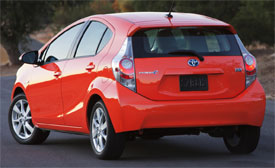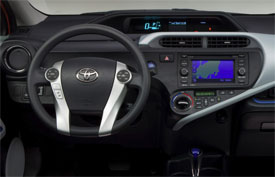2012 Toyota Prius c
By now you’ve heard much about the Toyota Prius family of hybrid cars. Well, the latest member to join the family is its smallest one yet, the Prius C. The C-for-city promises the best around town fuel economy of any non-plug-in hybrid on the road. But, is there anything more to the C, than just good mpg?
Every family is happy to see a new “little-one” arrive, and this 2012 Toyota Prius C is no exception. With great fuel economy being one reason that more people are looking at smaller cars and certainly the main reason people buy hybrids, the C looks to be the perfect marriage of the two and the right car at the right time.
But before we declare that, let’s download the data. The Prius C is based on a shortened Yaris chassis, so when we say it’s a small car, we’re not exaggerating. Wheelbase is just 100.4-inches. Overhangs, both front and rear are very brief, making it appear even shorter than it is. Overall length is just 157.3-inches.
Standard wheels are steel and 15-inches in diameter, with 16-inch alloys optional. Up front, the look is familiar Prius, but with sizable trapezoidal grille openings that help to give it a sportier tilt.
 The rear-end tapers in a bit to optimize aerodynamics, which are also helped by a hatch-top rear spoiler. Tall, vertical tail lights wrap up into the fenders to help give the look some substance. Good thing since the C only weighs 2,500 pounds, or about 500 less than the standard Prius.
The rear-end tapers in a bit to optimize aerodynamics, which are also helped by a hatch-top rear spoiler. Tall, vertical tail lights wrap up into the fenders to help give the look some substance. Good thing since the C only weighs 2,500 pounds, or about 500 less than the standard Prius.
So, not surprisingly it is powered by a downsized Hybrid Synergy Drive system, starting with a 1.5-liter I4 rated at 73-horsepower and 82 pound feet of torque. That little engine-that-almost-can gets much needed help from a pair of electric motor-generators to give a combined output of 99-horsepower.
All of that gets you a Government Fuel Economy Rating of 53 City on Regular gas. While that’s the best of any current hybrid, its highway rating of 46 is actually less than the larger Prius, so the C’s combined rating of 50 is the same.
Energy Impact Scores also match the regular Prius at a stingy 6.6-barrels of oil per year, while emitting only 2.9 annual tons of CO2.
Despite the miniature powertrain, the C’s light weight makes it feel more spirited than its larger brethren. Still, we estimate the 0-to-60 time is similar at about 10.5 seconds.
You can tool around in ECO and EV modes only; there’s no Power mode like the larger cars, and power still flows through a foggy CVT transmission, so there’s nothing sporty to note here either.
For a car that’s designed to be a “city car”, the C holds its own on highways just as well. We never felt a lack of power, but we did have fairly low expectations going in. Visibility is good all around, and the C doesn’t feel tiny when you’re behind the wheel; it’s also quieter than the typical subcompact.
The tilt/telescoping steering wheel has redundant controls, and as in all other current Prius’, Smart Key with keyless entry and push button start is standard.
 The two-tone interior is a good mix of youthful styling with comfort and user-friendliness. Seats are cloth except for top- level C4 trim that get SofTex simulated leather. The folding rear seat is either 1 or 2 piece, depending on which grade you purchase and trunk capacity is generous at 17.1 cubic-feet.
The two-tone interior is a good mix of youthful styling with comfort and user-friendliness. Seats are cloth except for top- level C4 trim that get SofTex simulated leather. The folding rear seat is either 1 or 2 piece, depending on which grade you purchase and trunk capacity is generous at 17.1 cubic-feet.
In current Prius vein, the dash-top gauge cluster includes a color info screen with a multitude of different fuel economy screens, and on the passenger side of the dash is a media tray with USB and auxiliary inputs.
With four trim levels, pricing begins at $19,710 for a Prius C One. That’s some 3 grand less than the standard Prius. The top level C Four is stickered at $23,990.
There’s no argument that the best selling point of the 2012 Prius C is its great fuel economy. But beyond that, the C is also a pretty decent subcompact overall. Add in a well equipped price that doesn’t break the bank, and it looks like the C is indeed more than just good MPG.
Specifications
- Engine: 1.5-liter I4
- Horsepower: 73
- Torque: 82 lb-ft.
- 0-60 mph: 10.5 seconds
- EPA: 53 mpg city/ 46 mpg highway
- Energy Impact: 6.6 barrels of oil/yr
- CO2 Emissions: 2.9 tons/yr
2024 Polestar 2
More Range And More Power For The Polestar 2
Volvo is well on their way to making the transition to an all-electric brand, but their sister-brand Polestar is already there. Now, we’ve spent lots of time in their all-wheel drive, five-door Polestar 2, having tested it in 2021, and a year later when a two-wheel drive version arrived. But, EV updates are coming quickly. So, let us be your guide for all that’s new with the Polestar 2.
While we are driving more EVs than ever, we’ve also been spending a lot of time recently circling back to ones we’ve previously tested. As in this new era of electrified vehicles, significant updates are arriving quickly, with R&D investments increasing and retrofitting them easier than ever. This is often done through software updates that can even be accomplished over the air. For 2024, the Polestar 2 has indeed gotten some software updates, but some physical ones as well.
Clearly aimed directly at Tesla’s Model 3 when it arrived; the Polestar 2’s build quality was vastly better, but range definitely came up short. So, addressing that was priority No. 1; and for ’24 the Polestar can travel up to 20% farther than before while consuming 9% less energy, and when it comes time to charge it back up, it can do that 34% faster too.
Range in the Single Motor version increases from a max of 270 to 320 miles thanks to a larger 82-kWh battery pack, and that solitary motor now powers the rear wheels, not the front wheels. It’s also bigger, coming in at 220 kW compared to the previous 170 kW front-wheel drive version, going from 231 to 299 horsepower.
Dual Motors keep the same 78-kWh battery, but still sees a boost from 260 to 276 miles and takes advantage of the larger rear motor for a new combined 310-kW output with 421 horsepower. Our test car has the added Performance Pack, which uses an additional 35 kW to deliver 455 horsepower and 546 lb-ft of torque, though max range drops to just 247 miles.
The new battery in rear-drive 2s will also charge faster, now accepting up to 205 kW for an 80% charge in 20 minutes; max for dual-motors stays at 155 kW, which puts an 80% charge at 34 minutes. Using 32 kWh of electricity per 100 miles, the Dual Motor earns a good efficiency rating.
The [Polestar] 2 has always been one of the most enjoyable EVs to drive, even more so now with that additional power coming from the rear motor.
Unfortunately, extremely cold temperatures kept us from seeing that increased range, as we were only on pace for about 194 miles in our test.
The 2 has always been one of the most enjoyable EVs to drive, even more so now with that additional power coming from the rear motor. And especially when equipped with the Performance Pack as it not only includes more power, but adds 20-inch forged wheels, upgraded brakes, and adjustable Ohlins Dual Flow Valve performance dampers. It greatly improves handling prowess without affecting ride quality, and is easily worth the $5,500 charge if you at all enjoy driving.
Even on a 20-degree track day there was plenty of grip through our handling course. No understeer or oversteer, and lots of feedback through the wheel. There was a nice, strong launch off the line that properly planted us firmly in the seat, and rocketed us to 60 in 4.5 seconds. Power delivery stayed pretty intense up until about 80 mph when there was a definite tapering off. Still, it was a 13.4-second quarter-mile at 102 mph; smooth, quiet, and stable the whole way.
When this car debuted, its Google-based infotainment setup was a novelty, but since then, more and more manufacturers are just “Googling it” so it doesn’t seem out of place at all. The wireless phone charger is easy to access, and there’s a great Harmon/Kardon sound system and panoramic sunroof to enhance the in-cabin experience. Exteriors have also been enhanced with a smooth grille insert and new wheel choices.
Hatchback practicality means 14.3 cu-ft of easy to access cargo space with split-folding seatbacks for longer items and expanding the space to 38.7 cu-ft. Plus, there’s even a sizeable storage bin up front under the hood.
Single Motor Polestar 2 pricing now starts at $51,300, with Dual Motors starting at $56,700; topping out at $64,400.
For a car manufacturer that hasn’t even been around for a decade yet, Polestar has kept itself busy, totally transforming their latest model in just a few years, making the 2024 Polestar 2 even more appealing. They are certainly off to a good start, and with a host of Polestars just over the horizon, including some all-important utility vehicles, this star will be shining even brighter.
Specifications
As Tested
- Motor Setup: Dual Motor
- Horsepower: 455
- 0-60 mph: 4.5 seconds
- EPA Range: 247 miles
- Efficiency : 32 kWh / 100 miles
- Battery Size: 78-kWh
- Torque: 546 lb-ft
- 1/4 Mile: 13.4 seconds at 102 mph
- MW Test Loop: ~ 194 miles
- Peak Charging Rate: 155 kW











































